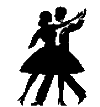 |
ROUND DANCING — CHOREOGRAPHED BALLROOMEDUCATIONAL ARTICLESMAJOR SECTIONS: Figures | Articles | Links | Alph. Index | Search | Home |
|
|
Three Gentle Remindersby Harold & Meredith Sears Recently, three different teachers have taken us aside and urged us to change our ways, and we thought you might enjoy thinking about these features of your own dancing. If you had been there, would they have chided you, too? These are not terribly complex or sophisticated features of dance styling, but that doesn't mean that they are easy to master, especially if they have been cemented into habit over time. Don't scuff your feet. In different dances, we are asked to glide, brush, drag, pull, limp, scoot, and maybe to do a "floor" ronde, but we are not really supposed to scrape or shuffle our feet along the surface of the floor. If those in the seats can hear the "shoosh, shoosh" of our passing, especially if it goes so far as to interrupt their quiet conversation, then we need to pick up our feet. Am I so hard of hearing that I can't hear these scrapings? Am I weak or lazy and unable to pick them up? Probably I just can't think of too many different things at the same time. Skim just above the surface of the floor, but not on the floor. Don't look at your partner.It's ironic. Here, we have our partners in our arms, the music is sweet, the lights are low, the mood is romantic—and we can't gaze into their eyes. We really do need to keep our heads up and our eyes left, most of the time. It is a question of our individual balance and our counterbalance relative to our partner. If we look at our partner, whether it is adoringly or questioningly, we shift our own balance toward her. Both of our positions are disturbed. She will feel pushed. Our frame loosens, and she won't feel a clear lead or will feel the wrong lead. Men, you may worship your partner, but do it a bit from afar. Don't grimace or scowl. The casual view of dancing is one of lightness and joy. It is the carefree flitting of the butterfly among soft, meadow breezes. But we dancers have a more complete picture. Some of those routines are demonic, requiring hard work and concentration. So what do you do as you listen to the cues, furiously struggle to turn those sometimes meaningless words into coordinated action, think about what your partner is doing and what you might do to facilitate and mesh with all that, and maybe keep an eye on nearby dancers with a view to avoiding collisions? Do you frown? Squint with the effort and purse or twist your lips in concentration? Do you emit little grunts or squeals of pain and frustration? Well, don't do that. This is fun; it's your recreation—smile. Round dancing is not a simple activity. There are over 20 different rhythms and hundreds of different figures. Choreographers and cuers throw these steps at us faster than we can think. On top of what they tell us to do, we need to layer extras like lead and follow, rise and fall, footwork, maybe sway and slice, a little Latin hip here, some contra-body over there. The old joke is about how hard it is to do two things at one time (walk & chew gum). Round dancing certainly gives us more than two. And on top of all of this, I need to lift my feet, look left, and smile.
This article was published in the Washington Area Square Dancers
Cooperative Association (WASCA) Calls 'n' Cues, 49-7:9,
3/2009; reprinted in the Texas Round Dance Teachers Association
Newsletter, 9/2011; and in the North Carolina Round Dance Association
Quarterly Newsletter, February 2012, and again February 2013.
If you would like to read other articles on dance position, technique, styling, and specific dance rhythms, you may visit the article TOC. Past DRDC Educational Articles archived here. Go beyond this site. Find other references on our Sources and Links pages.
|
 |
|
|